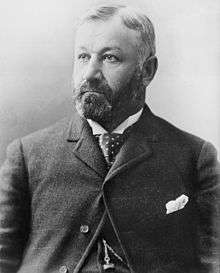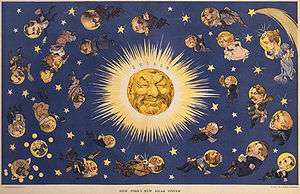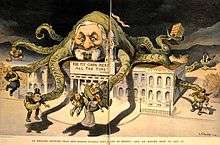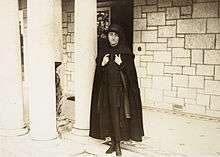Richard Croker
| Richard Croker | |
|---|---|
 | |
| Grand Sachem of Tammany Hall | |
|
In office 1886–1902 | |
| Preceded by | John Kelly |
| Succeeded by | Lewis Nixon |
| Member of the New York City Council | |
|
In office 1868–1870 | |
| Personal details | |
| Born |
November 24, 1843 Ardfield, County Cork, Ireland |
| Died |
April 29, 1922 (aged 78) Stillorgan, County Dublin, Ireland |
| Political party | Democratic |
| Spouse(s) |
Elizabeth Fraser (m. 1873; her death 1914) Beulah Edmonson (m. 1914; his death 1922) |
| Children | 7 children |
| Profession | Coroner, mobster |
Richard Welstead Croker Sr. (November 24, 1843 – April 29, 1922), known as "Boss Croker," was an Irish-American politician who was a leader of New York City's Tammany Hall and a political boss.[1]
Biography

Richard Croker was born in the townland of Ballyva, in the parish of Ardfield, six miles south of Clonakilty in County Cork on November 24, 1843,[2] son of Eyre Coote Croker (1800-1881) and Frances Laura Welsted (1807-1894).[3] He was taken to the United States by his parents when he was just two years old. They boarded the Henry Clay in Cobh, County Cork and headed for the land of opportunity.[4]
There were significant differences between this family and the typical family leaving Ireland at that time. They were Protestant, and were not land tenants. Eyre Coote Croker owned an estate in Ardfield, in south west Cork.[5] Upon arrival in the United States, Eyre Coote Croker was without a profession, but he had a general knowledge of horses and soon became a veterinary surgeon. During the Civil War, he served in that same capacity under General Daniel Sickles.[3]
Richard Croker was educated in New York public schools. He joined one of the Volunteer Fire Departments in 1863, becoming an engineer of one of the engine companies. That was his gateway into public life.[5] He eventually became a member of Tammany Hall and active in its politics. He was an alderman from 1868–70, Coroner of New York County, New York from 1873-76. He moved to Harrison, New York by 1880. He was appointed the New York City Fire Commissioner in 1883 and 1887 and city Chamberlain from 1889-90.
%2C_Rogers_A_Cinch_1893_Cornell_CUL_PJM_1112_01.jpg)
After the death of John Kelly he became the leader of Tammany Hall, and for some time almost completely controlled that organization. As head of Tammany, Croker received bribe money from the owners of brothels, saloons and illegal gambling dens. He survived Charles Henry Parkhurst's attacks on Tammany Hall's corruption and became a wealthy man.
Croker's greatest political success was his bringing about the 1897 election of Robert A. Van Wyck as first mayor of the five-borough "greater" New York, and during Van Wyck's administration Croker is popularly supposed to have completely dominated the government of the city. After Croker's failure to carry the city in the presidential election of 1900 and the defeat of his mayoralty candidate, Edward M. Shepard in 1901, he resigned from his position of leadership in Tammany and was succeeded by Lewis Nixon. He departed the United States in 1905.[6]
Thoroughbred racing

Croker operated a stable of thoroughbred racehorses in the United States in partnership with Mike Dwyer. In January 1895, they sent a stable of horses to England under the care of trainer Hardy Campbell, Jr. and jockey Willie Simms. Following a dispute, the partnership was dissoved in May but Croker continued to race in England.[7]
In 1907, his horse Orby won Britain's most prestigious race, The Derby. Orby was ridden by American jockey John Reiff whose brother Lester had won the race in 1901. Croker was also the breeder of Orby's son Grand Parade who won the Derby in 1919.
Later life and death
Richard Croker married twice. He first married in 1873 to Elizabeth Fraser (b. abt. 1853 in New York, d. 6 September 1914 in Berne, Switzerland).[8][9] They had several children, including:
- Richard Samuel Croker "Jr." (30 March 1877 in New York – aft. 1940),[8][9] attended Brown University and married 12 March 1898 to Mary Brophy,[10] without issue.
- Francis H. "Frank" Croker (15 Sep 1878 in Fordham, Bronx County, New York – 22 Jan 1905 in Ormond Beach, Florida).[8][9] His monumental grave was erected by his father following his death from injuries sustained in avoiding a motorcyclist while automobile racing.[11] No issue.
- Joseph Croker (January 1880 in New York – bef. 1890)[8]
- Herbert Vincent "Bertie" Croker (abt. 1882 USA – 12 May 1905)[9]
- Florence Genevieve Croker (b. 7 October 1884 in Manhattan, New York),[9] married at least two times.
- Howard F. Croker (b. 5 May 1886 in New York City, New York – January 1979),[9][12] married 1 May 1915 on Long Island to Gertrude White (b. 19 Oct 1893, Cedarhurst, Long Island, New York)[13]
- Ethel J. Croker (b. 16 July 1888 in New York City, New York),[9][14] married Thomas Francis White (b. 19 December 1882).
He was married to Beulah Benson Edmondson (1884–1957[15]) in November 1914 when he was 71 years old.[16]

She was of American Indian descent, her tribal name being Ketaw Kaluntuchy.[17]
He died on April 29, 1922 in Ireland.[1]
He left an estate estimated to $3–5 million to his second wife, Beulah, disinheriting his estranged children.[18] A note in his handwriting, dated at Glencairn, November 15, 1919 read as follows:[19]
My dear Bula [sic]: I am writing this note for you to keep and in case you should survive me I wish you would give my daughter Florence ten thousand pounds. She is the only one of my surviving children who has ever shown any graditude to me. (Signed) Richard Croker.
This resulted in a celebrated lawsuit in which the children, Richard Croker Jr., Ethel Croker White and Howard Croker, unsuccessfully claimed that their father's second marriage was invalid for bigamy, in that their stepmother was at the relevant time married to another man. They were, however, unable to produce any credible evidence that the gentleman existed. Croker had converted to Catholicism shortly before his death, but this does not appear to have played a role in his disinheriting his children.[20]
Croker's funeral drew some of Dublin's most eminent citizens, The Times (of London) describing it as follows (the 'Alderman Macdonagh' referenced being Joseph MacDonagh:[21]
FUNERAL OF MR. CROKER: - The funeral of Mr. Richard Croker took place yesterday [May 5, 1922], when the body was buried in the grounds of Glencairn House, Mr. Croker's residence in South County, Dublin. After a Requiem Mass in the private oratory, the burial service was conducted by the Right Rev. Dr. W.J. Miller [Roman Catholic Titular Bishop of Eumenia] ... The body was clothed in evening dress, and before the coffin was closed Mrs. Croker desired the mourners to look at her husband's face for the last time. The coffin was covered with a pall made of natural violets and evergreen. The pall-bearers were Mr. Arthur Griffith, President of Dáil Éireann, the Lord Mayor of Dublin, Mr. A.H. Flauley, of Chicago, Mr. Oliver Gogarty, Alderman Macdonagh, and Mr. J.E. Tierney. Mr. Michael Collins, Chairman of the Provisional Government, was represented by Mr. Kevin O'Shiel. Mr. James MacMahon, British Under-Secretary to the Lord Lieutenant, was also in attendance.
References
- 1 2 "Richard Croker Dies In His Irish Castle As Result Of Cold". New York Times. April 29, 1922. Retrieved June 14, 2007.
Ex-Tammany Boss, Aged 80 Suffered Exposure On Trip From America In October. Dictator Here 16 Years Gang Leader, Prize Fighter, Alderman, Coroner Before He became Tammany's Chief. Made Fortune In Politics Went Abroad To Live And Wonderby. Last Years Embittered By Fight With Children. London, April 29, 1922. Richard Croker, former leader of Tammany Hall, died at 3:30 o'clock this afternoon at Glencairn Castle, his residence in County Dublin.
- ↑ New York Times [April 12, 1927. Date from 1911 EB article; other sources say 1841. The 1880 US Census shows a Richard Croker, an ex-coroner at that date, born in Ireland in 1843, living in Harrison, Westchester, New York. It does not show any other Irish-born Richard Croker. Found by searching for the relevant terms at , October 7, 2006.
- 1 2 "Death of Richard Croker's Mother". The New York Times. New York. 1894-08-10. Retrieved 2017-06-22.
- ↑ Kramer, Rita (February 1973). "Well, what are you going to do about it?". AmericanHeritage.com. American Heritage Magazine. Retrieved August 26, 2010.
- 1 2 Clarke, J.I.C. (July 14, 1907). "Richard Croker -- The Story Of His Ancestry" (PDF). The New York Times. The New York Times Company. p. SM4. Retrieved August 28, 2010.
- ↑ 1915 U.S. Passport Application for Richard W. Croker, accessed April 2017
- ↑ "Croker and Dwyer Part Company". The New York Times. 2012-06-10. Retrieved 2016-12-12.
- 1 2 3 4 1880 U.S. Federal Census: Richard Croker. Accessed April 2017.
- 1 2 3 4 5 6 7 1890 U.S. Passport Application of Richard Croker and family. Accessed April 2017.
- ↑ Massachusetts Marriage Records: Richard Samuel Croker
- ↑ Find-a-Grave: Francis H. "Frank" Croker, accessed April 2017
- ↑ U.S. Social Security Death Index: Howard Croker, accessed April 2017
- ↑ 1923 U.S. Passport Application of Gertrude White Croker, accessed April 2017
- ↑ 1914 U.S. Passport Application of Ethel J. Croker. Accessed April 2017.
- ↑ "Biographical data on Bula Edmonson". Freepages.genealogy.rootsweb.ancestry.com. Retrieved 2008-07-22.
- ↑ "Photo from the wedding". Archived from the original on December 8, 2007. Retrieved July 22, 2008.
- ↑ "Princess Ketaw Kaluntuchy Now Mrs. Richard Croker," The Coffeyville Daily Journal, Coffeyville, Kansas, November 30, 1914, page 4
- ↑ "Children cut off by Richard Croker" (PDF). The New York Times. May 22, 1922. Retrieved 2008-07-22.
Entire Estate, Estimated at 3 to 5 Millions, Goes to His 'Indian Bride.' Richard Croker left nothing to his four children ...
- ↑ "Undue Influence By Mrs. Croker Charged In Protest To Probating Croker's Will Filed By Children". The Palm Beach Post. West Palm Beach, Florida. 1922-07-29. Retrieved 2017-06-22.
- ↑ Kenneth D. Ackerman (2011-12-19). BOSS TWEED: The Corrupt Pol who Conceived the Soul of Modern New York. Books.google.com. p. 399. Retrieved 2016-12-12.
- ↑ The Times, May 6, 1922.

Further reading
- Lewis, Alfred Henry (1901). Richard Croker. New York: Life Publishing. OCLC 459654271.
- Zink, Harold B. (1930). City Bosses in the United States: A Study of Twenty Municipal Bosses. pp. 128–46.
| Party political offices | ||
|---|---|---|
| Preceded by John Kelly |
Tammany Hall 1886–1902 |
Succeeded by Lewis Nixon |